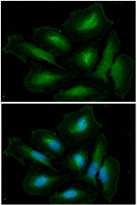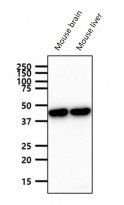ARG57501
anti-Glutamine Synthetase antibody [8D7]
anti-Glutamine Synthetase antibody [8D7] for ICC/IF,Western blot and Human,Mouse
Overview
| Product Description | Mouse Monoclonal antibody [8D7] recognizes Glutamine Synthetase |
|---|---|
| Tested Reactivity | Hu, Ms |
| Tested Application | ICC/IF, WB |
| Host | Mouse |
| Clonality | Monoclonal |
| Clone | 8D7 |
| Isotype | IgG1, kappa |
| Target Name | Glutamine Synthetase |
| Antigen Species | Human |
| Immunogen | Recombinant Human Glutamine Synthetase (aa. 1-373) purified from E. coli. |
| Conjugation | Un-conjugated |
| Alternate Names | GS; PIG43; Glutamate decarboxylase; EC 6.3.1.2; PIG59; Glutamine synthetase; Glutamate--ammonia ligase; GLNS; EC 4.1.1.15 |
Application Instructions
| Application Suggestion |
|
||||||
|---|---|---|---|---|---|---|---|
| Application Note | * The dilutions indicate recommended starting dilutions and the optimal dilutions or concentrations should be determined by the scientist. |
Properties
| Form | Liquid |
|---|---|
| Purification | Purification with Protein A. |
| Buffer | PBS (pH 7.4), 0.02% Sodium azide and 10% Glycerol. |
| Preservative | 0.02% Sodium azide |
| Stabilizer | 10% Glycerol |
| Concentration | 1 mg/ml |
| Storage Instruction | For continuous use, store undiluted antibody at 2-8°C for up to a week. For long-term storage, aliquot and store at -20°C. Storage in frost free freezers is not recommended. Avoid repeated freeze/thaw cycles. Suggest spin the vial prior to opening. The antibody solution should be gently mixed before use. |
| Note | For laboratory research only, not for drug, diagnostic or other use. |
Bioinformation
| Database Links | |
|---|---|
| Gene Symbol | GLUL |
| Gene Full Name | glutamate-ammonia ligase |
| Background | The protein encoded by this gene belongs to the glutamine synthetase family. It catalyzes the synthesis of glutamine from glutamate and ammonia in an ATP-dependent reaction. This protein plays a role in ammonia and glutamate detoxification, acid-base homeostasis, cell signaling, and cell proliferation. Glutamine is an abundant amino acid, and is important to the biosynthesis of several amino acids, pyrimidines, and purines. Mutations in this gene are associated with congenital glutamine deficiency, and overexpression of this gene was observed in some primary liver cancer samples. There are six pseudogenes of this gene found on chromosomes 2, 5, 9, 11, and 12. Alternative splicing results in multiple transcript variants. [provided by RefSeq, Dec 2014] |
| Function | This enzyme has 2 functions: it catalyzes the production of glutamine and 4-aminobutanoate (gamma-aminobutyric acid, GABA), the latter in a pyridoxal phosphate-independent manner (By similarity). Essential for proliferation of fetal skin fibroblasts. [UniProt] |
| Calculated MW | 42 kDa |
| PTM | Ubiquitinated by ZNRF1. |
Images (2) Click the Picture to Zoom In
-
ARG57501 anti-Glutamine Synthetase antibody [8D7] ICC/IF image
Immunoflorescense: HeLa cells stained with ARG57501 anti-Glutamine Synthetase antibody [8D7] at 1:100 dilution. The secondary antibody (green) was used Alexa Fluor 488. DAPI was stained the cell nucleus (blue).
-
ARG57501 anti-Glutamine Synthetase antibody [8D7] WB image
Western blot: 40 µg of Mouse brain and Mouse liver tissue lysates stained with ARG57501 anti-Glutamine Synthetase antibody [8D7] at 1:1000 dilution.







